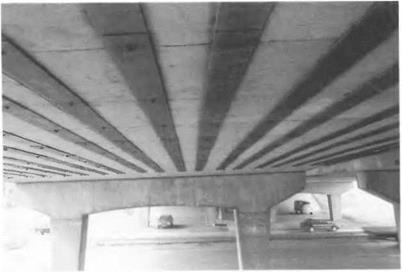Many of the comments about the use of adhesives in building apply equally to civil engineering. The section on Historical Development outlined some of the uses of natural adhesives, for joining wood or
|
Fig. 1.4. Barnett Bank Centre, Miami, Florida; 15 floors, 4-sided structural silicone glazing. |
material such as asphalt or flexible road and runway pavements. Since the 1950s synthetic polymer materials such as PVACs, SBRs and acrylic polymers have been used as general purpose bonding agents and adhesives, for example to improve the adhesion of surfaces. Whilst unsaturated polyesters, polyurethanes and acrylics all have their place among the applications for thermosetting adhesives, epoxy resins remain the major candidate materials for use in essentially non-structural situations such as:
(1) industrial flooring in the form of either pourable self-levelling systems or trowelled filled compositions.
(2) water-proofing membranes on concrete bridge decks
(3) skid-resistance layers on roads and other surfaces
|
Fig. 1.5. Brickell Bay Office Tower, Miami, Florida; 28 floors, 4-sided structural silicone glazing. |
(4) resin mortars or concretes for expansion joint nosings on bridge decks, as a seating for bearing pads, and as a material for the surface repair of spalled concrete
(5) low viscosity formulations for the injection and sealing of cracks in concrete
(6) bonding new concrete to old, for the extension or repair of existing structures
(7) bonding of road marker studs to asphalt surfaces
(8) grouts for soil and rock consolidation
(9) epoxy coated bar reinforcement in structural concrete
(10) epoxy powder coatings as a protective layer to steel pipelines
|
|
|
|
|
Several applications utilise adhesives in a semi-structural manner in which the stresses to be resisted are dominantly compressive. These include:
(11) wire, rope or strand anchors
(12) steel fixings in concrete, rock or masonry
(13) self-levelling epoxy grouts for the support of heavy machinery, and as a bedding medium (resistant to indirect tensile forces) for crane and other rails
(14) segmental precast prestressed concrete structures such as bridges, in which epoxides have been used for nearly 30 years as a stress-distributing waterproof medium in joints.
Many of these applications will be considered further in Part 2 of the book, as will civil engineering uses of adhesives in a truly structural sense. By the latter it is implied that the adhesive is used to provide a shear connection between similar or dissimilar materials which enables the components being bonded to act as a composite structural unit. Within this definition, the main applications are:
(15) ‘glulam’
(16) bonded external plate reinforcement for strengthening existing concrete structures
(17) bonded composite steel/concrete bridge decks
(18) structural steelwork connections
(19) sleeved steel bar and rebar connectors
A casein-adhesive-bonded arch made in 1910 supports the main roof of Oslo railway station to this day, and glulam is now a well established material for the construction of timber portals in buildings and for curved beams in roof structures and footbridges. It is often overlooked that glulam members of large cross-section have far greater fire resistance than corresponding ones of steel or concrete, and merely char as though composed of solid homogeneous timber. There is a steady demand, albeit limited in the UK, for concrete bridges and buildings to be strengthened using external steel plate reinforcement bonded selectively to their tension or shear surfaces (Fig. 1.8). Adhesives have been used to form the shear connection between steel and concrete in deck slabs in composite bridges, bonding to both (hardened) precast slabs and to fresh concrete. Such concepts have aroused interest in the US for the replacement of decks in highway bridges suffering from rebar corrosion. The use of adhesives to provide truly structural connections in steelwork is
|
Fig. 1.8. Strengthening of bridge structure with externally bonded steel plate reinforcement. |
very much in its infancy, whilst rebar connectors are still under development.
 29 июня, 2015
29 июня, 2015  Malyar
Malyar 




 Опубликовано в рубрике
Опубликовано в рубрике 